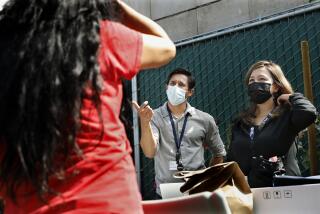New Strategies in AIDS Prevention
- Share via
The bells of Hollywood United Methodist Church rang for 20 minutes--each minute marking the years since the onset of the AIDS epidemic in the United States.
In a small ceremony on Tuesday, volunteers from AIDS Project Los Angeles read names in memory of 1,000 friends and clients who have died of the disease.
Twenty years after the first cases were reported in Los Angeles, health officials say battle lines in the AIDS epidemic have changed, but their warnings haven’t: Practice safe sex. Don’t share needles. Get tested.
“It’s an enormous struggle,” said Sergio Avina of the AltaMed Jovenes in Action HIV prevention program. “We’re still saying the same message and still giving out condoms. We haven’t made much progress.”
Though the disease continues to disproportionately affect gay men, it has over time spread increasingly among heterosexuals and minorities.
And as more women, African Americans and Latinos have become infected, health workers have had to adjust their messages, to become more resourceful.
Among other steps, health workers and volunteers now distribute information to pastors serving African American congregations, offer testing at massage parlors and bars in Koreatown and Chinatown, even drive a low-rider emblazoned with “Be safe, use condoms” at car shows attended by young Latinos.
“We’re struggling with the Latino and African American communities,” said Craig Thompson, executive director of Aids Project Los Angeles, who has worked in AIDS prevention for 10 years. “We need the kind of community-based effort we had in the early ‘80s [for gay men] that focuses on African American and Latino men.”
But proponents of such outreach say national and state funding for HIV prevention does not always support their nontraditional efforts.
“We’re not really allowed to have very innovative approaches,” Avina said. “We’re funded to provide a very clinical approach.”
Still, in addition to counseling, testing and support groups, AltaMed Jovenes in Action tries to promote HIV awareness and prevention through monthly talent showcases with bands, singers, poetry, art exhibits and a drag-queen show. It also visits malls, schools, gay nightclubs and underground house parties to distribute condoms and HIV information.
Meanwhile, Lia Margolis, director for the Latino Coalition for a Healthy California, said her organization is working to increase funding for outreach to a much different group: middle-aged Latinas. In communities where homosexuality remains stigmatized, women can be unwittingly infected by husbands or boyfriends who are secretly having sex with other men.
“If there’s a real face of AIDS that has changed, it’s this one,” she said. “There hasn’t been, to my knowledge, a very concerted effort to address some of their issues.”
Today, there are an estimated 900,000 men and women living with HIV in the United States. About 70% of new infections each year occur among men, according to data from the federal Centers for Disease Control and Prevention. Though the highest incidence of new infections is among men who have sex with men, about one-third of new cases each year are among heterosexuals.
More than half of all new infections each year are among African Americans.
Complacency, unsafe use of intravenous illegal drugs and the unfounded notion that AIDS is a curable disease have challenged prevention efforts, said Dr. Jonathan Fielding, director of Los Angeles County Public Health Services.
In addition, officials say early characterizations of AIDS as a “gay man’s disease” continue to hamper prevention efforts. In fact, said Fielding, “a significant portion of the population is still not practicing safe sex.”
Gunther Freehill, of the Los Angeles County Office of Aids Programs and Policies, said prevention has become more complicated as the disease has struck more diverse populations, many of which have a multitude of social and health problems.
“If you’re looking at a neighborhood that needs school repairs, safer streets and decent housing, HIV prevention may not get the attention that it deserves,” Freehill said. “We need to not just look at all the needs of the HIV-affected person, but the needs of the HIV-affected communities.”
(BEGIN TEXT OF INFOBOX / INFOGRAPHIC)
Two Decades of AIDS in Los Angeles
Reflecting national trends, the number of new AIDS cases in Los Angeles County--which crested 11 years after the epidemic was officially recognized in 1981--has declined dramatically in recent years. But the disease, which began among gay men, is striking a far broader range of victims.
1981: 20 cases
1992: 4,182 cases
2000: 1,238 cases
Breakdown of cases in . . .
*--*
1985 2000 White men 67.3% 25.3% Latino men 14.3% 38.8% Black men 13.2% 18.9% White women 2.1% 2.4% Asian men 1.7% 1.6% Black women 0.6% 5.7% Latino women 0.8% 6.5% Asian women 0% 0.2% Other 0% 0.6%
*--*
Source: Los Angeles County HIV Epidemiology Program
More to Read
Sign up for Essential California
The most important California stories and recommendations in your inbox every morning.
You may occasionally receive promotional content from the Los Angeles Times.













